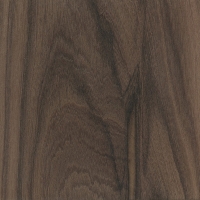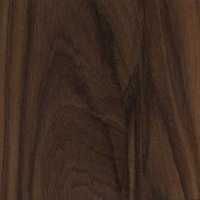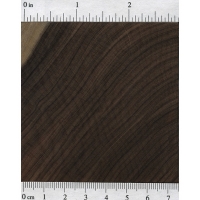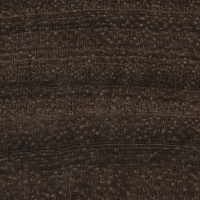 |
Common Name(s): Siamese Rosewood, Vietnamese Rosewood, Thai Rosewood, Cambodian Rosewood Scientific Name: Dalbergia cochinchinensis Distribution: Thailand, Cambodia, Vietnam, and Laos Tree Size: 65-100 ft (20-30 m) tall, 2-3 ft (.6-1 m) trunk diameter Average Dried Weight: 65 lbs/ft3 (1,035 kg/m3) Specific Gravity (Basic, 12% MC): .85, 1.03 Janka Hardness: 2,430 lbf (10,790 N) Modulus of Rupture: 24,800 lbf/in2 (171.0 MPa) Elastic Modulus: 2,375,000 lbf/in2 (16.38 GPa) Crushing Strength: 16,970 lbf/in2 (117.0 MPa) Shrinkage: No data available |
Color/Appearance: Heartwood is a medium to dark reddish brown with darker brown to black streaks throughout. Sapwood is a pale yellowish white, sharply demarcated from heartwood.
Grain/Texture: Grain is straight to slightly interlocked. Medium to fine uniform texture with good natural luster.
Endgrain: Diffuse-porous; solitary and radial multiples of 2-3; large to very large pores in no specific arrangement, few to very few; heartwood deposits (yellow and dark brown) common; parenchyma diffuse-in-aggregates, winged, banded, and reticulate; narrow rays, spacing normal to fairly close.
Rot Resistance: Reported to be very durable, though seldom used in applications where rot resistance is required.
Workability: Despite its density and occasionally interlocked grain, workability is fairly good. As with all rosewoods, Siamese Rosewood can be difficult to glue or finish. Turns well.
Odor: Mild scent not resembling most rosewoods in the Dalbergia genus.
Allergies/Toxicity: Although severe reactions are somewhat uncommon, Siamese Rosewood has been reported as a sensitizer. Usually the most common reaction is skin irritation, as well as other effects such as rashes or hives. See the articles Wood Allergies and Toxicity and Wood Dust Safety for more information.
Pricing/Availability: Increasingly scarce due to recent CITES restrictions. Turning blanks and burls are occasionally available. Prices are high for an imported hardwood.
Sustainability: Siamese Rosewood is listed on CITES appendix II under the genus-wide restriction on all Dalbergia species—which also includes finished products made of the wood. It is also listed on the IUCN Red List as vulnerable due to a population reduction of over 20% in the past three generations, caused by a decline in its natural range, and exploitation (see comments section below).
Common Uses: Fine furniture, turned objects, musical instruments, and other small specialty wood items.
Comments: Although beautiful and venerated as a true rosewood in the Dalbergia genus, Siamese Rosewood has been one of the central species in illegal logging in Asia. To help put it in perspective, as of 2013, the largest remaining Dalbergia cochinchinensis tree in Thailand is currently guarded day and night by an entire platoon of Thai soldiers. Siamese Rosewood may fairly be called a blood wood, and sadly, the label has nothing to do with the color of the wood.
- African Blackwood (Dalbergia melanoxylon)
- Amazon Rosewood (Dalbergia spruceana)
- Brazilian Rosewood (Dalbergia nigra)
- Burmese Blackwood (Dalbergia cultrata)
- Burmese Rosewood (Dalbergia oliveri)
- Cocobolo (Dalbergia retusa)
- East Indian Rosewood (Dalbergia latifolia)
- Honduran Rosewood (Dalbergia stevensonii)
- Kingwood (Dalbergia cearensis)
- Madagascar Rosewood (Dalbergia baronii)
- Sissoo (Dalbergia sissoo)
- Tulipwood (Dalbergia decipularis)
- Yucatan Rosewood (Dalbergia tucurensis)








I bought some seeds Dabergia cochinchinenis for Colombian ranch, but have no knowledge of plant requirements, sprouting reqirements..no knowledge on temperature requirements, elevation specs.
Anyone out there who has any knowledge on this species please respond.
hello Erik, i got some rare wood from Vietnam, im sure it is Dalbergia but im rely not sure wich one. In Vietnam is used name : Tr?c lào a : i take some photos in mine resarch it is weight arround 900 kg. Wood in sanding smels nicely but not like comon rosewood. It smels les but stil nicely. I add some photos may you recognize that wood. It looks lke Dalbergia cochinchinensis but not that wich you have published, Thx alot Tom.
It does look like C?m Lào alright. But the word Lào just means that it is harvested in the country of Lao. If it is truely a Vietnamese rosewood. Its name would most likely be Cam Lai Do – Red Vietnamese Rosewood. Which of course will be of this Dalbergia cochinchinensis or Dalbergia Oliveri. No offense to the author but Non of the Pictures here truely express the beauty of a Quality Vietnamese rosewood so it is understandable that you have this question. But rest assured, yours do seem like a quality piece of Vietnamese rosewood.
I am a wood lover from decades and that is why I believe that endangered species such as D.cochinchinensis should be protected. So that future generations have a chance to admire trees, but maybe also wood. Unfortunately, the illegal trade of this blood wood is common on the largest portals like ebay or Etsy, not to mention Chinese sellers.
I am trying to indentify a gift from Vietnam where the wood is called ” trac, with a letter “c” above the a and an accent egue on the c”
Another wood i=s called Huang. Both are exquisite turning pieces, and I do suspect a dalbergia as the class
Im Vietnamese and what you call as “tr?c” is actually dalbergia cochinchinensis, and “huang” is dalbergia tonkinensis prain
Trac is not dalbergia, but called Erythrophleum. Cam lai in Vietnam is dalbergia cochine…
Trac = Dalbergia cochinchinensis
Cam lai = Dalbergia oliveri
Huang = Pterocarpus macrocarpus
Trac = Dalbergia conchinchinensis (2nd most expensive)
Cam Lai = Dalbergia oliveri / bariensis / dongnaiensis
Sua = Dalbergia tonkinensis (1st most expensive)
Is cochien rosewood a common name for dalbergia cochinchinensis? or is cochien rosewood a different wood altogether?
People Suck. Leave the trees alone.
I cut some branches on a Siamese rosewood on my property in northern Thailand. The sap is dark red and looks like slightly watered down blood. I also planted about 15 on my property. The sapwood is reddish now, but judging from the photos in this report, I expect it to change to brown as it cures.
About what age does the tree produce seeds?
HI Kip
Would you have some of this wood for sale we are looking for 2 pieces from one meter ling 6 cm thick and between 3 and 22 cm wide
Regards
Wandee